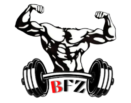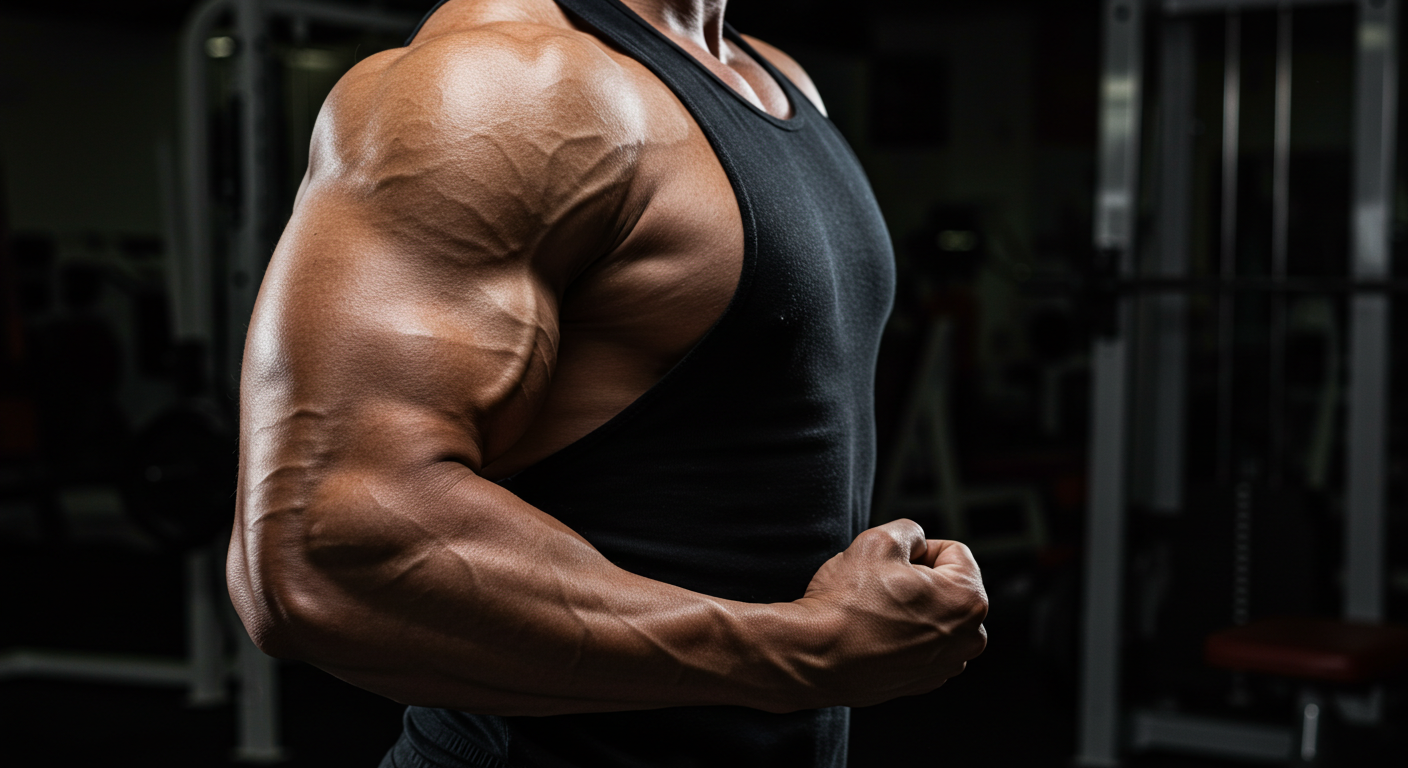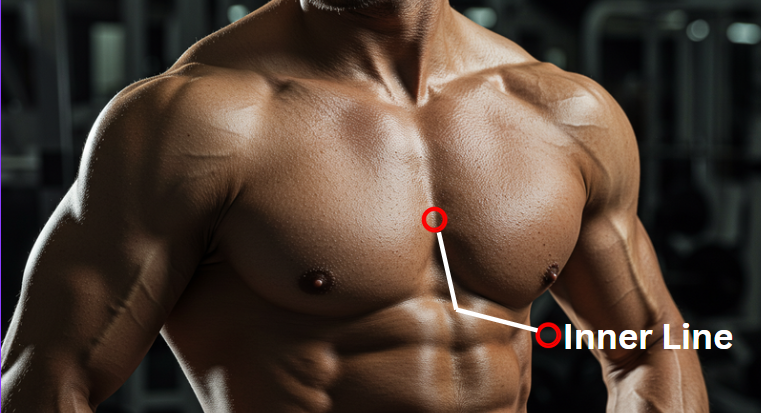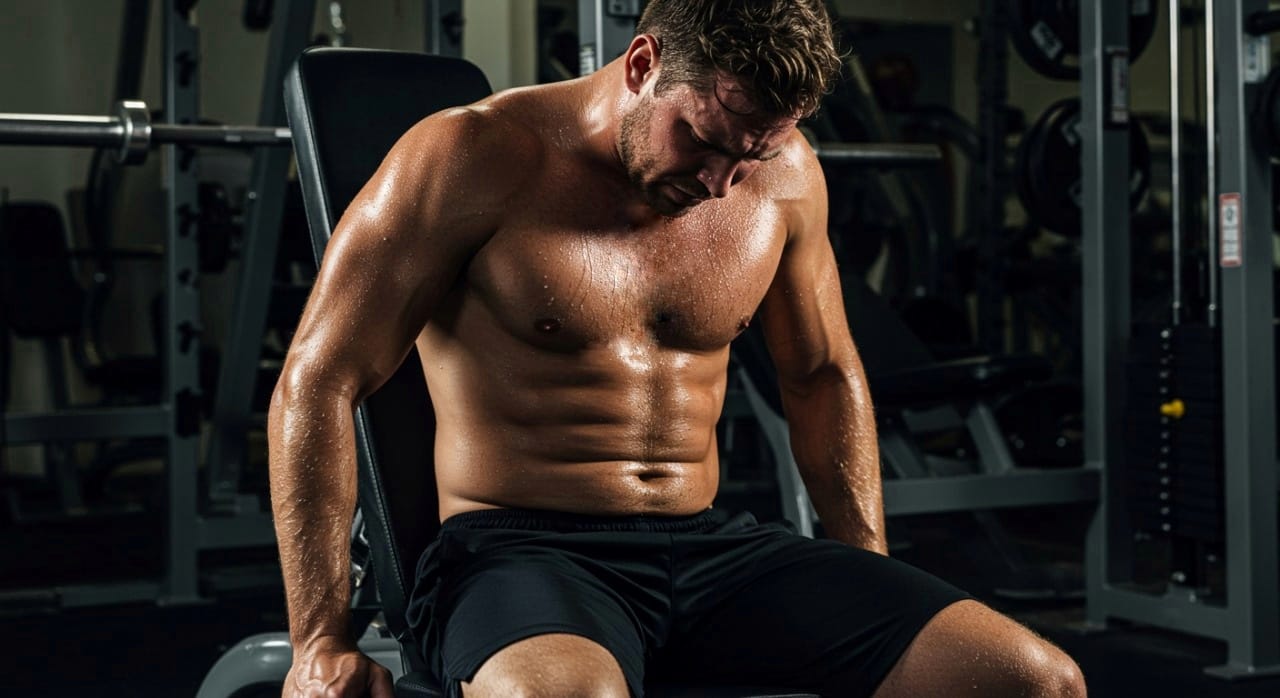The chest is the most visible muscle, even when you wear clothes. It shows how strong your physique is and how hard you lift in the gym. Not only that, but it also enhances your personality and boosts your confidence everywhere. The lower chest line is the part that gives your chest an aesthetic look. However, many people complain that they can’t get their chest in shape.

This is because you’re not hitting the lower pecs correctly. Most chest exercises tend to target the entire muscle group together. Therefore, if you don’t specifically isolate and hit your lower chest, it won’t develop properly.
In this article, we are going to explore the reasons your chest is not growing and share with you six of the best exercises to sculpt your chest and give it an aesthetic look.
Lower Chest Anatomy
Your chest is composed of three large muscles:

- Clavicular Head (Upper Chest)
- Sternal Head (Middle Chest)
- Abdominal Head (Lower Chest)
Your lower chest starts just below the middle chest, originating from the sternum, and ends right above the abs. This muscle activates during the adduction movement, which means when you bring your hands close to your chest. It also aids in pushing and pressing movements.
Best Exercises to Target Your Lower Chest
- Incline Push-Up
- Decline Bench Press (Dumbbell or Barbell)
- Decline Dumbbell Hammer Press
- Decline Cable Press
- Chest Dips
- Pullover
- Cable Crossover
Incline Push-Up
A basic compound exercise that targets your overall chest. By simply changing the angle, you can shift the stimulation to different parts of the chest. One of the most effective variations for the lower chest is the incline push-up. If your lower chest is weak, start with this exercise first before progressing to other variations.
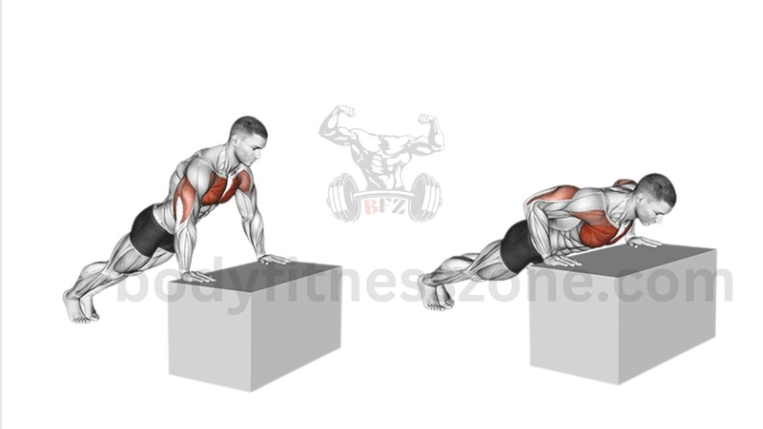
How to Perform:
- First, find an elevated surface for the incline. Make sure the surface is not inclined more than 30 degrees; going higher shifts the load to your shoulders and mid-chest instead of your lower pecs.
- Place your hands shoulder-width apart on the surface. Walk your feet back and ensure your body forms a straight line from your head to your heels.
- Slowly lower your chest by bending your elbows toward the surface. Focus on stretching your lower pec muscles with full mind-muscle connection.
- Press through your hands to return your body to the starting position and squeeze the muscle at the top. Avoid arching your back or sagging your hips during the movement.
- Aim for 15–20 reps with 3 sets, ensuring the last two sets are performed to failure.
Benefits:
Incline push-ups help build a defined chest by focusing on the lower chest due to the incline position. They also target the shoulders and triceps, improving overall upper body strength. Additionally, this exercise doesn’t require any equipment, making it suitable for home workouts. It places less stress on the wrists, making it a comfortable option if you have wrist joint issues.
Decline Bench Press (Dumbbell or Barbell)
Using free weights makes this exercise more effective, allowing you to get the maximum stretch. If you use dumbbells, you can lower the weights a bit more than with a barbell, making your workout more challenging.
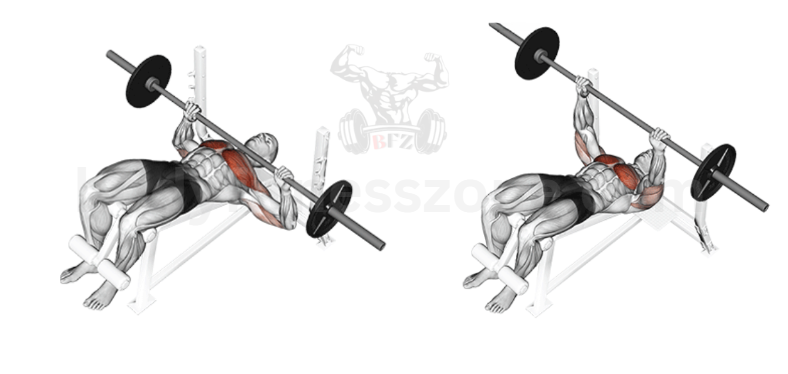
However, remember not to use any adjustable bench that doesn’t have a leg-supported pad. You must have a knee pad-supported machine. When you push the weight up, you might slip from the bench due to the decline angle. There’s also a risk of the weight falling on your face due to instability, and it’s tough to maintain proper posture without leg support. So, always use a decline bench machine, which you’ll find in every gym, even the most affordable ones.
How to Perform:
- Lie down on a decline bench machine, holding two dumbbells in each hand with your legs properly secured in the leg-supported pad. If using a barbell, select weights according to your strength.
- Unrack the barbell or press the dumbbells up by extending your arms. Your grip should be slightly wider than shoulder-width.
- Slowly lower the weight in a controlled manner by bending your elbows. Take at least 3 seconds to lower it until it touches your chest. Feel the stretch and breathe in.
- Hold for half a second, then push back to the starting position, squeeze the muscle, breathe out, and repeat.
- Aim for 8–12 reps with 3 sets.
Benefits:
This exercise targets your chest and triceps, helping them grow and increasing your stability. The decline bench position greatly emphasizes your lower chest, which is crucial for building thickness and definition.
Decline Dumbbell Hammer Press
Use the same decline bench press machine where you get the knee and foot support pads. This exercise helps target your upper portion from a different angle, which is optimal for muscle growth and definition.

How to Perform:
- Lie down on the bench, holding a dumbbell in each hand.
- Arch your back, which helps lift your chest up, emphasizing the effectiveness of the exercise.
- Lift the dumbbells up in a neutral grip, with your palms facing forward. This is your starting position.
- Slowly lower the dumbbells in a controlled manner, keeping tension on your lower chest. Try to take them a little lower than parallel to your chest for a deeper stretch, and breathe in through your nose.
- Press the dumbbells back to the starting position until your arms are fully extended, squeeze your muscles, and breathe out through your mouth.
- Aim for 12–15 reps with 3 sets.
Benefits:
The lower angle effectively targets your lower pecs. Additionally, using a neutral grip targets that area from different angles, which is optimal for muscle growth. Moreover, using dumbbells allows each arm to move freely, enhancing muscle balance and coordination.
Decline Cable Press
Using a cable machine makes this exercise more effective. It helps to fully stretch your chest, increase blood flow, and promote muscle mass. Additionally, the decline position targets your lower pecs more effectively than other angles.

How to Perform:
- First, set up the cable machine by attaching the pulleys at the lowest position and attaching a D-handle to each pulley.
- Set the bench between the pulleys and adjust the angle for a decline.
- Lie on the bench, grabbing the handles in each hand and extending them out to the sides at shoulder height. Arch your back to lift your chest up, effectively targeting the lower pecs.
- Start pressing the handles forward, bringing them together while keeping your elbows slightly bent. Focus on adduction—press as if your biceps are pressing against your chest—and breathe out.
- Slowly release and return the handles, trying to feel the negative tension. Keep your elbows slightly bent and breathe in. Don’t extend too much, as it can cause muscle strain.
- Aim for failure with 3 sets.
Benefits:
The cable machine is ideal for building an aesthetic chest. It helps maintain negative tension throughout the exercise and pumps more blood into your chest. The extreme stretch is necessary for muscle growth, and the decline position allows for a deeper contraction of the lower pecs.
Chest Dips
This exercise is slightly different from the traditional parallel bar dip, as it changes the angle. The use of the dip machine allows for better chest stimulation because you’re using your entire body weight during the workout. Be careful not to go too low during the exercise, as your shoulders are heavily involved, and lowering your body too much may cause shoulder injury.

How to Perform:
- Stand on the foot pads of the machine and grab the handles with a shoulder-width grip, palms facing inward.
- Press yourself up, bend your knees, and tighten your core. This will help stabilize your body and prevent swinging. Most importantly, lean your torso slightly forward, around 30–45 degrees.
- Slowly lower your body in a controlled manner, breathing in. Be cautious not to lower too much to avoid shoulder strain.
- Push yourself back up until your arms are fully extended. Squeeze your chest and breathe out.
- Make sure to maintain a consistent contraction throughout the exercise, and keep your elbows pointed backward. Aim for 15–18 reps with 3–4 sets.
Benefits:
Since you’re using your body weight, this exercise becomes more challenging, allowing for a deeper stretch, which makes it more effective. It not only targets your chest but also engages your triceps, helping you build an aesthetic chest while improving your strength and flexibility.
Dumbbell Pullover
By using a dumbbell and bench, you can target your lower pecs and tone the muscles. It’s a compound exercise. Try to lift moderately heavy weights, but not excessively heavy, as your shoulders are deeply involved, and the position may not feel very comfortable. If the weight is too light, your pecs won’t get the proper stretch. On the other hand, lifting too heavy increases the risk of shoulder injury.

How to Perform:
- Lie on a bench with your back supported, and place your feet flat on the floor. Your body, from head to knee, should be in a straight line.
- Select a dumbbell that allows you to perform 12–15 reps. Hold it with both hands, slightly bending your elbows, and bring it over your chest.
- Slowly lower the dumbbell backward and down toward your hips, feeling the stretch in your lower chest, and inhale.
- Push your hands to bring the dumbbell back to the starting position. Maintain contraction throughout the exercise, and exhale.
- Aim for 12–15 reps with 2–3 sets.
Benefits:
As a compound movement, the dumbbell pullover targets your lower chest, triceps, and lats, helping you focus on achieving a deep stretch while maintaining contraction throughout the exercise. This effective targeting promotes muscle growth and helps you reach your desired results.
Cable Crossover
You need a cable machine to perform this exercise, and a cable machine is one of the best tools for training your chest. It ensures that your chest remains continuously under tension, through both the contraction and elongation phases, which is optimal for muscle growth. The cable machine allows you to achieve maximum mind-muscle connection, helping your chest activate more and increasing blood flow, which is great for pumping up the muscles.
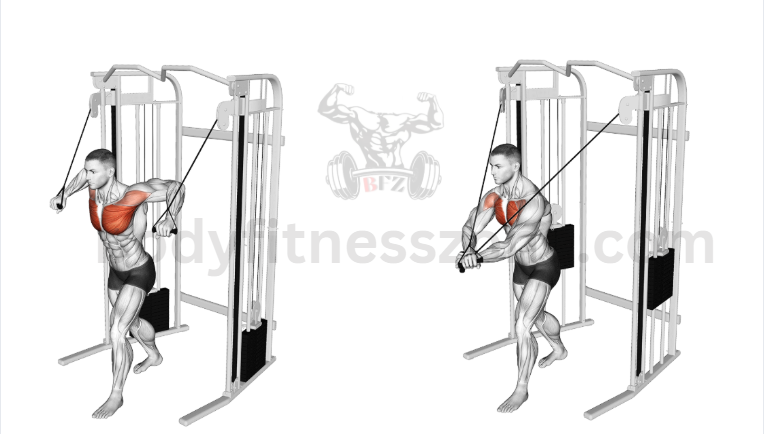
How to Perform:
- First, adjust the pulleys to the highest position on the cable machine and attach a D-handle to each.
- Grab the handles with your palms facing downward and inward, and stand in the center of the cable machine.
- Take one foot slightly forward to help balance your body during the movement. Extend your hands outward to shoulder height, keeping your elbows slightly bent to reduce strain on your joints. Tighten your core, and keep your chest up and your back straight.
- Bring the handles downward until full adduction, meaning your arms should be fully extended in front of you, squeezing your chest. Hold the squeeze for 1–2 seconds.
- Slowly return your hands to the starting position in a controlled manner, maintaining tension and feeling the stretch. Don’t pull too far back, as this could strain your shoulder joints. Keep your elbows slightly bent throughout the movement.
- Aim for 12–15 reps with 3 sets. The last two sets should be taken to failure.
Benefits:
The cable machine allows you to isolate and train your chest effectively. It provides a full range of motion and ensures complete muscle activation. Additionally, it puts less strain on your joints compared to free weights, helping you reduce the risk of injury while strengthening your chest and improving flexibility. It also helps you develop a better mind-muscle connection.
Some Reasons Your Lower Chest Is Not Growing
Excess Body Fat
Your chest won’t grow until you remove the excess fat from it, especially since fat tends to accumulate in your lower chest. To grow your chest without obstacles, your body fat percentage should stay between 15-17%. Even if your muscles are growing, they won’t be visibly well-defined until you reduce your body fat percentage. To address this, design a proper diet and include cardio alongside weight training.
No Progressive Overload
Without increasing the weight, you won’t be able to build more muscle. Remember, muscles grow more when they are put under greater stress. Your chest is a large muscle, and if you don’t gradually increase the weight, you won’t be able to develop a well-defined, aesthetic chest.
Not Getting Enough Stimulation
Your muscles only receive proper stimulation when they are adequately stretched, remain fully under tension, and are exercised through a full range of motion with proper mind-muscle connection. Many people engage in ego-lifting, believing they need to lift heavy weights to build big muscles. However, by focusing only on moving the weight upwards and neglecting the necessary components for proper stimulation, they ultimately hinder their chest progress.
Not Maintaining Good Posture
This is something you can fix right now. Stop slumping over. No matter how well-developed your chest is, slumping will negatively affect its shape. When we create an arch in one area, the skin folds, and folded areas make fat more visible. Not only that, but fat also accumulates more in that area because blood circulation decreases, making it more prone to fat accumulation. If this becomes a long-term habit, the muscles surrounding the arched area will weaken.
Ignoring the Chest Fibers
It’s important to stimulate your muscles according to the direction of their fibers, meaning you should train them at the appropriate angle. When it comes to building your lower chest, it gets the best stimulation when you train it in an upward-to-lowered position, with a decline angle of around 20–30 degrees. These angles allow you to achieve the most stretch while maintaining tension throughout the workout.
The Bottom Line
The lower chest is the part of your chest that you can feel more and is key to giving your chest a well-rounded, aesthetic shape. However, building this area can be tough because fat tends to accumulate most in this region.
That said, if you reduce your body fat percentage to a standard level and perform all the exercises mentioned in this article with focus, control, and full mind-muscle connection, you can be confident that your lower chest will develop quickly.
